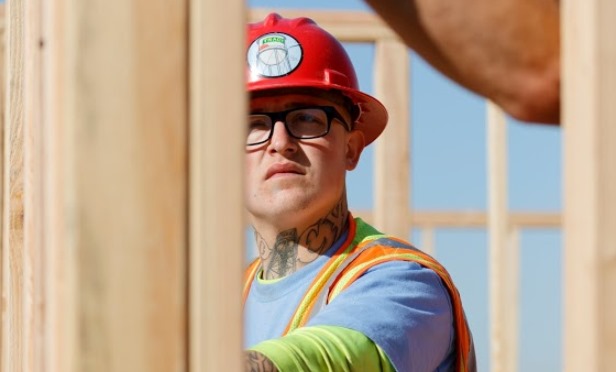 Using a factory-type assembly-line setting allowed for completion of the six tiny homes in five weeks.
Using a factory-type assembly-line setting allowed for completion of the six tiny homes in five weeks.
CASTRO VALLEY, CA—In a push to help house the working homeless, HomeAid Northern California is leading a team of homebuilders and contractors that designed, constructed and installed six tiny homes at the First Presbyterian Church of Hayward at 2490 Grove Way. The tiny homes were moved to the permanent location last week.
Dubbed tiny homes because of their compact size, each 157-square-foot home will be equipped with everything residents need–kitchen, bed and shower–during their transition from homelessness into permanent housing.
Team members include Pulte Homes, Brookfield Residential, Branagh, William Lyon Homes, Richmond American Homes and XL Construction with CoBuild acting as the project manager. In this exclusive, HomeAid Northern California executive director Cheryl O'Connor shared some insights into the tiny home project, costs to construct the homes, permitting process and the factory-built aspect.
GlobeSt.com: Which real estate executives are involved in HomeAid?
O'Connor: These are high-level home building industry leaders. HomeAid projects include all of the major homebuilders in Northern California volunteering their time and resources. For this Tiny Home Project, a weekly update call is held with up to 22 executives including principals. It is inspiring to see senior-level home building executives from competing companies all joining in to build these six tiny homes. The end of the year is a very busy time for them. They want to help because this is what they do: help others less fortunate by building homes for people experiencing homelessness. As with many others, they are on the front lines of the housing affordability crisis and want to help house people however they can. This also allows them to help raise awareness around potential solutions.
Among our goals at HomeAid is to join the volunteer builder executives with the housing-industry trades. This includes recruiting the many subcontractors for all the work that goes into a home. HomeAid acts like a matchmaker, getting these various industries and leaders to donate or greatly reduce costs.
In addition to this tiny homes project, we regularly create homes for those in need, and in the past 20 years, HomeAid has saved over $11 million in construction costs for 45 shelter projects to house the homeless in the Bay Area.
GlobeSt.com: What is the cost to build these tiny homes?
O'Connor: The cost to design, construct and install the six tiny homes at the First Presbyterian Church of Hayward was approximately $240,000 for all six homes or about $40,000 each. Even for tiny homes, each is 157 square feet, this is an incredibly low cost. It points out how much fees are a factor driving the cost of housing. The HomeAid team and the church are able to save money on certain fees because they are factory-built on a parking lot. On the church site, the homes will be connected to the church utilities, which will save thousands of dollars in costs and months saved in approval time. This creative cost structure was developed by First Presbyterian Church in Hayward which already has a housing program for its congregation and community members.
Similar dramatic cost savings come through the compressed time frame. The normal time to process housing permits to completion can be up to five years. This project began this year. Move-in day is in January 2020.
GlobeSt.com: How does the permitting process get condensed into a shorter timeframe?
O'Connor: The county of Alameda changed its housing element designation to include tiny homes as a type of home allowed in the county, which reduces the approval time for our tiny home project and all new tiny home projects going forward in the county. Other Bay Area counties are considering the same concept. We also asked the utility companies to allow tying the tiny home utilities into the existing church utilities which cuts down new hook-up fees for water and power as well as time to process any new utility connections. That usually adds six months to a year in processing time.
In January, there will be an event to thank all of the people who made this project happen including the builders, their trade partners and the county governing members who worked with the church on the approval process. The event will also offer an opportunity for everyone to meet the new residents who will have a new place to call home.
GlobeeSt.com: Please expand on the factory-built aspect that provides a lower cost product.
O'Connor: By building the homes in a factory-type assembly-line setting, the approval process for the homes goes through the state's housing and community development department/HCD instead of a city or county jurisdiction. This cuts down on fees and time to process, because the working drawings and inspections are done with HCD approvals and not local city or county approvals. We call for inspections at certain milestones and an inspector visits the factory and inspects the homes. This allowed us to complete the six tiny homes in five weeks. The normal course of construction for a home constructed on a lot would be three to six months long.
© Touchpoint Markets, All Rights Reserved. Request academic re-use from www.copyright.com. All other uses, submit a request to [email protected]. For more inforrmation visit Asset & Logo Licensing.







